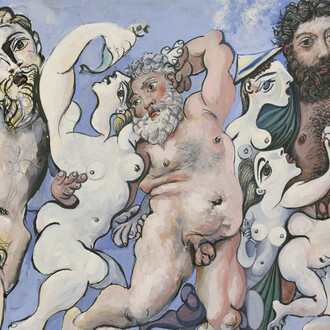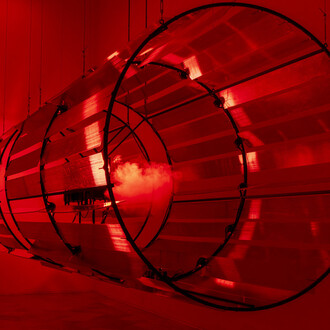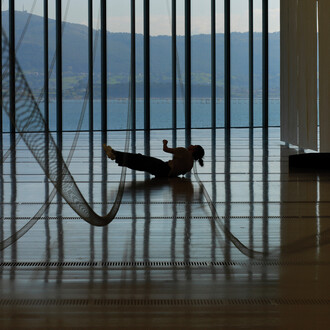The exhibition Peirao is organized around the work of the same name, a painting conceived, both in its scale and its pictorial rhythm, as the axis from which the other works unfold. Around it, conceptual affinities, resonances, and chromatic contrasts emerge, together with a measured rhythm that unfolds in the temporality of a perceptual experience.
In Galician, the noun peirao refers to a harbor’s dock. Still, it also shares an Indo-European root (per) with the Greek verb peiráō, meaning “to attempt, to cross,” and with the archaic Latin perior, from which the word “experience” derives. Peirao thus evokes at once a place of passage and an act of searching.
From this idea of threshold, the painting Peirao is built on a dialogue between the longitudinal horizontality of the format and the verticality of the brushwork, its rhythm flowing from right to left, punctuated by caesuras. As Hölderlin observed in his reading of Greek tragedy, the caesura is not a passive pause, but an interruption that intensifies; a void that reorganizes time and concentrates meaning. During the process, Negro also recognized another conceptual resonance: Cy Twombly’s Treatise on the veil, where white chalk lines and notations unfold the painting like an open musical score.
In Peirao, the vertical caesuras play a similar role: they interrupt the painting’s horizontal course and reshape the time of its reading. Here, however, perception arises through the superimposition of layers and the vibration of glazes. Iridescent tones, green mixed with gold, rust red with copper, ensure the painting is never apprehended at once: the intensity of the light and color shift with the viewer’s gaze.
Two works were created alongside Peirao: Urda and Areallo. Both share initial chromatic foundations and a common base of monotype impressions that generated internal symmetries; yet, in the final veils, they diverged into different territories.
In Urda, the deep greens and rust reds inherited from Peirao’s intermediate stages generate an intense chromatic tension, yielding a painting that is both optical and tactile, where matter and light reach a precise balance.
Areallo, by contrast, opens onto a more airy, expansive register: on layers of greens, golds, and graphite, the final blue glaze activates a weightless, almost suspended space. In the search for that exact tone, the blues of Pontormo’s Trasporto di Cristo served less as a quotation than as a chromatic horizon, guiding the decision of how the surface should breathe.
Though autonomous, these three works work as a resonant nucleus around which the exhibition gravitates. Their dialogue expands through the presence of works from earlier cycles that do not interrupt their reading but instead contextualize it, establishing conceptual links with paintings where kindred explorations were already in play, open processes attuned to latent tensions. In this way, Peirao becomes not only a point of anchorage but also a place of passage: a space where different stages of the artist’s path converge, generating an internal genealogy that connects materials, processes, and times of painting.













![Saul Steinberg, The museum [El museo] (detalle), 1972. Cortesía del Museo de Arte Abstracto Español](http://media.meer.com/attachments/dfbad16c22c5940b5ce7463468ac8879f3b4bf23/store/fill/330/330/042ecf3bcd2c9b4db7ddbc57cb32e950c095835f7b5cd55b6e1576a6e78c/Saul-Steinberg-The-museum-El-museo-detalle-1972-Cortesia-del-Museo-de-Arte-Abstracto-Espanol.jpg)


